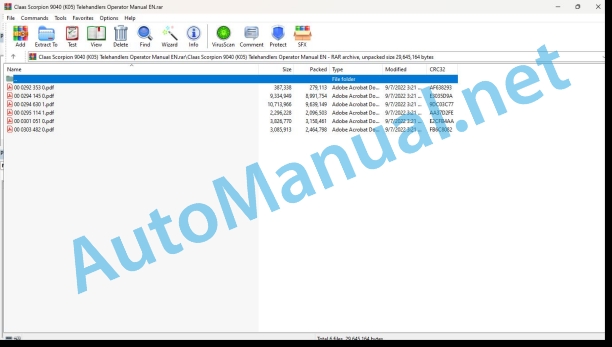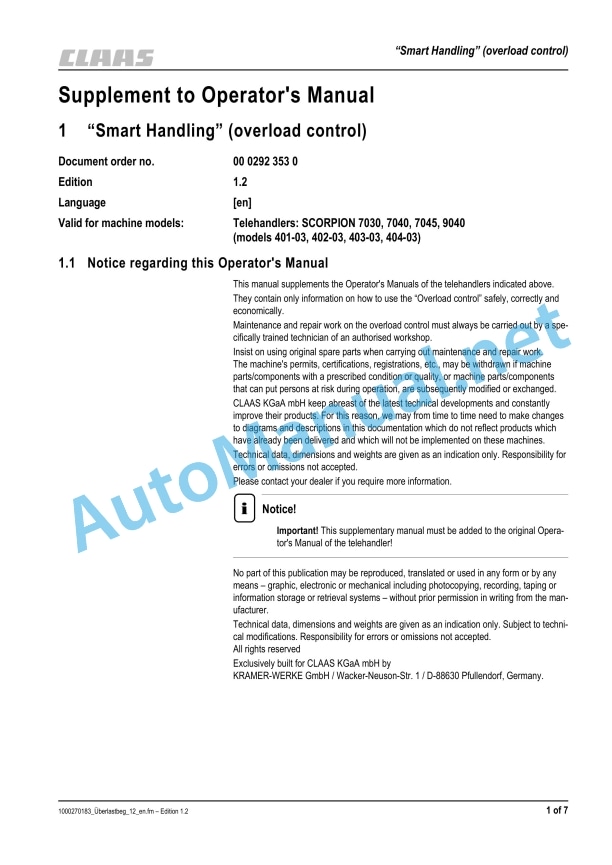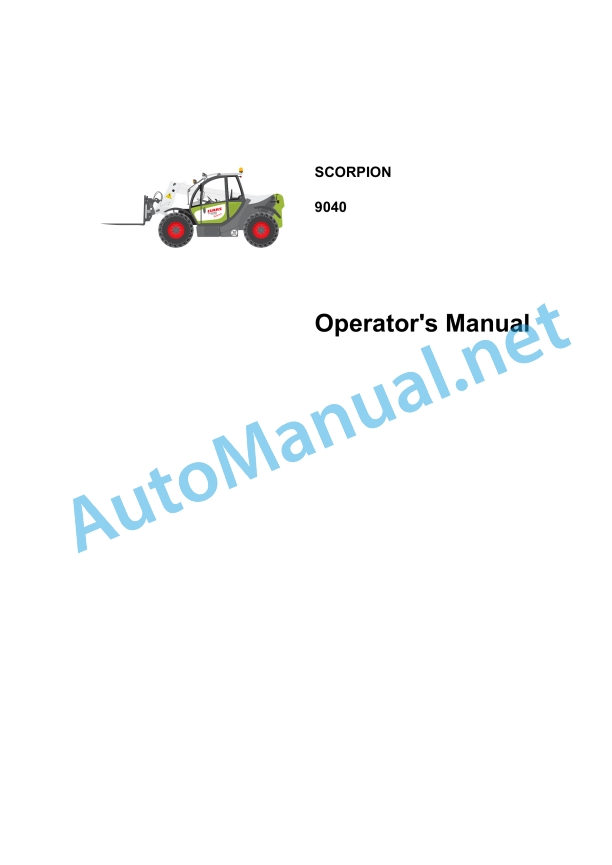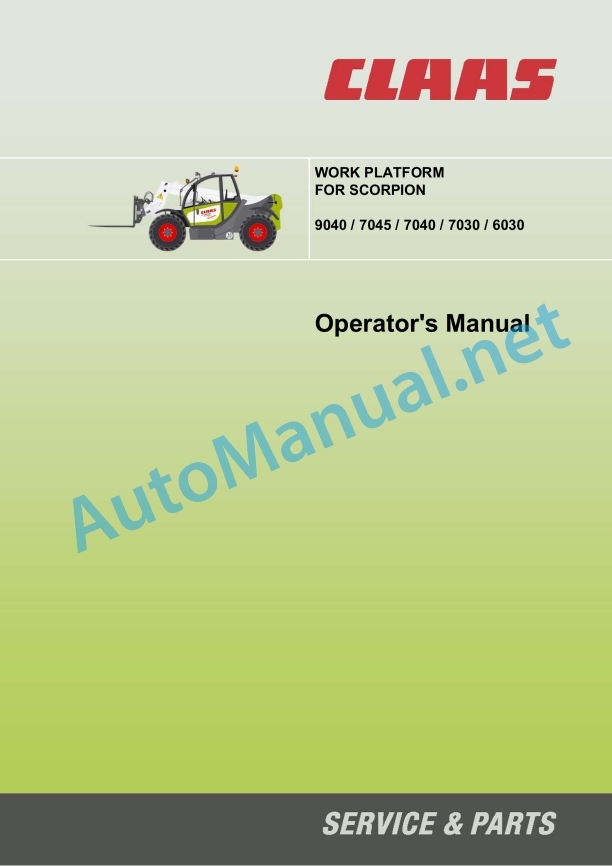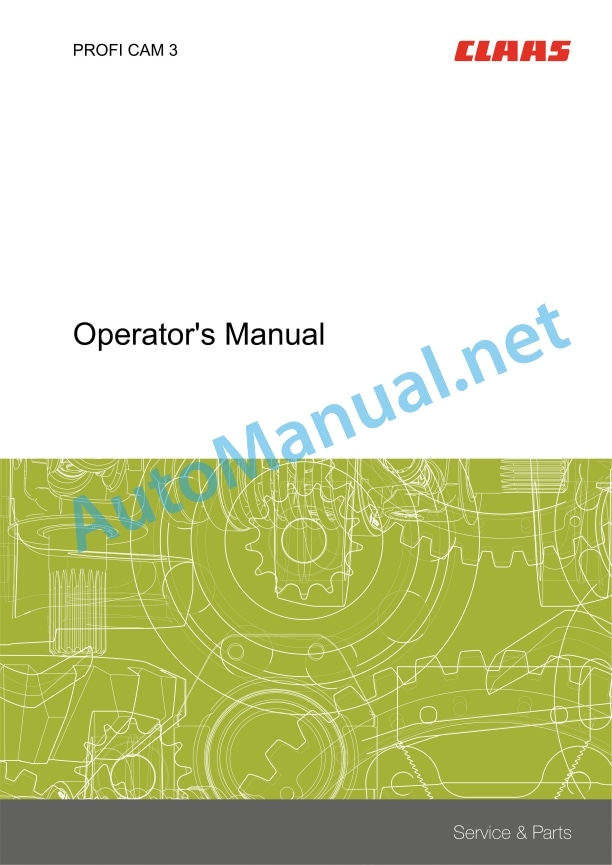Claas Scorpion 9040 (K05) Telehandlers Operator Manual EN
$50.00
- Model: Scorpion 9040 (K05) Telehandlers
- Type Of Manual: Operator Manual
- Language: EN
- Format: PDF(s)
- Size: 25.4 MB
File List:
00 0292 353 0.pdf
00 0294 145 0.pdf
00 0294 630 1.pdf
00 0295 114 1.pdf
00 0301 051 0.pdf
00 0303 482 0.pdf
00 0294 630 1.pdf:
Operator’s Manual
Table of contents
1 Introduction
1.1 Important information on this Operator’s Manual
Abbreviations/symbols
1.2 Machine overview
1.3 Model designation – trade names
1.4 Brief description
Hydrostatic drive
Work hydraulics and 4 wheel steering
Cooling system
1.5 Fields of application
1.6 Use: attachment
1.7 Regulations
Driving licence
Equipment
Machine inspections
Documents
Warning identification of the machine
1.8 EC declaration of conformity model 404-03
1.9 Type labels and component numbers
Serial number
Cab number
Engine number
Hydraulic pump number
Variable displacement motor number
Variable displacement motor number (high speed option)
Front and rear axle numbers
1.10 Signs and symbols
Labels on the outside of the machine
Labels on the inside of the machine
2 Safety instructions
2.1 Identification of warnings and dangers
2.2 Warranty
2.3 Designated use and exemption from liability
2.4 General conduct and safety instructions
Organisational measures
Selection and qualification of staff, basic responsibilities
2.5 Safety instructions regarding operation
Normal operation
Applications with lifting gear
Trailers and attachments
Transport
2.6 Safety instructions for maintenance
Service and maintenance work on ROPS/FOPS superstructures (ROPS bar)
2.7 Warning of special hazards
Electric energy
Gas, dust, steam, smoke
Hydraulic equipment
Oil, grease and other chemical substances
3 Operation
3.1 Overview of control elements
3.2 Cab overview
3.3 Instrument panel, multifunctional lever, switch consoles: overview
3.4 Telltales and warning lights: description
Telltale and warning light – instrument panel
Telltale and warning light – instrument panel
3.5 Taking the machine into service for the first time
Safety instructions
Important information
Running-in period
Check lists
Start-up checklist
Operation checklist
Parking checklist
Opening the door from the outside and inside
Opening/closing the side window
Completely opening and locking the side window
Opening/closing the rear window
Rear window emergency exit
Interior light
3.7 Before starting the engine
3.8 Starting the engine
3.9 Overview of error code displays (103 kW diesel engine from serial no. 404 03 0021)
Reading out the flash code
Warning limit – coolant temperature
Warning limit – charge-air temperature
Warning limit -engine oil pressure
Overview of flashing codes
3.10 Key-based drive interlock (option)
Coding (“training”) new ignition keys
Enabling (locking) the drive interlock
b (releasing) the drive interlock
Deleting coded keys
Safety functions
3.11 Drive interlock with code input (option)
Entering/changing the personal code
Enabling the drive interlock
Disabling the drive interlock
Taking the drive interlock out of service
Putting the drive interlock back into service again
Interruption of drive interlock power
Drive interlock maintenance
3.12 Oil and fuel preheater (option)
Oil preheater (option)
Fuel preheater (option)
3.13 Jump-starting the engine (external battery)
Safety instructions
If the jump-starting vehicle touches the telehandler –
Procedure
3.14 Before moving off
Special instructions for driving on public roads
3.15 Locking the control lever (joystick) and the 3rd control circuit (attachments)
3.16 Steering column height and angle adjustment
3.17 Checking the steering system
Turning the steering wheel requires greater effort! Take this into account especially when towing the machine!
3.18 Synchronous wheel position
3.19 Adjusting the height of the control lever base
3.20 Accelerator pedal
3.21 Manual throttle (option)
3.22 Brake/inching pedal
3.23 Parking brake
3.24 Moving off the telehandler
Moving off on slopes
Changing direction (forwards/reverse)
Selecting the speed range (0 – 20 kph)
Selecting the drive range (0 – 30/40 kph, option)
Low-speed control (option)
3.25 Electric mirror adjustment (option)
3.26 Load stabiliser (option)
General instructions
Switching the load stabiliser on and off
3.27 Backup warning system (option)
3.28 Differential lock
Switching on the differential lock
Switching off the differential lock
3.29 Synchronising the steering system
3.30 Changing steering mode
Changing over to front axle steering
Changing over to 4 wheel steering
Changing over to diagonal steering (crab steering option)
Changing over to diagonal steering at high speed –
3.31 Stopping/parking the machine
3.32 Light system
Headlights
Working lights
3.33 Signalling system
Turn indicators
Hazard warning system
Rotating beacon (option)
3.34 Cab heating and ventilation
3.35 Air conditioning (option)
3.36 Washer system
Tank for washer system
3.37 Seat
Seat adjustment
Weight adjustment
Height adjustment (air-suspension seat, option)
Backrest adjustment
Horizontal adjustment
3.38 Seat belt (lap belt)
After an accident the belt strap is stretched and no longer serviceable. In an accident, the seat belt
Fastening the seat belt:
Unfastening the seat belt:
Longer/shorter lap belt adjustment:
3.39 Engine cover
3.40 Fire extinguisher (option)
3.41 Battery master switch (option)
3.42 Reversing cooling fan (option)
3.43 Towing and transporting the machine
Getting ready for towing
Towing the machine
Once towing is over
3.44 Loading and transporting the telehandler
General safety instructions
Loading the machine
Strapping down the machine
3.45 Crane handling the machine
Safety instructions
Crane handling
3.46 Telescopic boom operation: overview
Operating the control lever for the lift, tilt and push-out rams
Operation of 3rd control circuit
3.47 Operating the telescopic boom
General safety instructions
Safe load indicator
Safe load indicator display
Functional check of the safe load indicator
Disabling/enabling the lock function of the safe load indicator (option)
Raising/extending the telescopic boom
Retracting/lowering the telescopic boom
Emergency lowering of the telescopic boom in case of a diesel engine breakdown
Fitting an attachment onto the hydraulic quickhitch
Fitting an attachment onto the mechanical quickhitch (option)
3.48 Hose burst valve safety feature
3.49 Mounting/removing the pallet forks
Driving on public roads with the pallet forks
3.50 Adjusting the fork arms
3.51 Working with the pallet forks
General safety instructions
Specific safety instructions
Brief instructions for fork arms
Load diagram for pallet forks (EN 1459/1998)
Maximum load depends on how the telehandler is equipped!
Approaching the material
Loading the material
Picking up material and setting it down in a high position
– with the telescopic boom raised and extended,
– with the upright fork frame tilted too far back,
– in strong wind and poor visibility –
Transport position without load
3.52 Working with the standard bucket
General instructions
Bucket payloads
Practical hints for digging
Tilt position of the bucket
Transport position of the bucket
Transporting with a full bucket
Loading loose material
Loading if the material is hard to penetrate
Removing material/digging in soft soil
Removing material/digging in hard soil
Loading vehicles
Freeing the machine
3.53 Working with a crane jib (option)
When working with a crane jib –
3.54 Mechanical oscillating axle interlock (rear axle)
3.55 Hydraulic rear oscillating axle interlock (option)
3.56 Frame levelling feature on front axle (option)
3.57 Continuous operation of 3rd control circuit (option)
3.58 Actuation: 3rd control circuit as additional front control circuit (option)
3.59 Operation: front/rear additional control circuit (option)
3.60 Tipping trailer operation (option)
3.61 Connection of electrically operated attachments (option)
3.62 Operation of the Autohitch trailer coupling (option)
3.63 Trailer coupling operation (option)
If the lock pin is not correctly coupled in the lower bore of the coupling jaw –
3.64 Compressed-air brake system (option)
General safety instructions
Coupling and uncoupling compressed-air hoses (dual-circuit brake system)
Uncoupling:
Coupling:
Compressed-air gauge
If the air pressure drops below 5 bar when driving
3.65 Hydraulic trailer brake connection (option)
3.66 Fitting attachments from other manufacturers onto the quickhitch (option)
Example: inspection plan for attachments from other manufacturers
4 Troubleshooting
4.1 Engine trouble
4.2 Malfunctions in the air conditioning system (option)
5 Maintenance
5.1 Introduction
5.2 Safety prop for telescopic boom
5.3 Fuel system
Specific safety instructions
Refuelling
Stationary fuel pumps
Diesel fuel specification
Checking/replacing the fuel prefilter (water separator)
Replacing the fuel filter
Bleeding the fuel system
5.4 Engine lubrication system
Checking the engine oil level
Filling up engine oil
Replacing the engine oil every 500 s/h (service hours)
Replacing the engine oil filter cartridge every 500 s/h (service hours)
5.5 Engine and hydraulics cooling system
Specific safety instructions
Checking the coolant level and quality
Filling up coolant
Draining coolant
Cleaning the radiator fins
Cleaning the radiator with the reversing fan (option)
5.6 Air filter
Checking air filter contamination
Replacing the air filter cartridge at 500 s/h (service hours)
5.7 V-belt
Retightening the V-belt
5.8 Hydraulic system
Specific safety instructions
Monitoring the hydraulic oil and the reflux filter
Checking the hydraulic oil level once a day
Filling up hydraulic oil
Important information for the use of biodegradable oil
5.9 Checking hydraulic pressure lines
Specific safety instructions
5.10 Lubrication work
General safety instructions
Lubricating the front and rear axle oscillation-type bearings
Lubricating the planetary drive bearing
Lubrication points on the telescopic boom: overview
Lubricating the telescopic boom
Checking and adjusting the wear plates
5.11 Lubricating with the central lubrication system (option)
General functional description
Setting the lubrication and break times
Filling the central lubrication system
5.12 Maintenance of the brake system
Specific safety instructions
Checking/filling up the brake fluid level
5.13 Maintenance: compressed-air brake system (option)
Checking the compressed-air tank and lines
Checking compressor attachment and drive
5.14 Tyres
Daily tyre checks
Changing wheels
5.15 Heating – fresh air
Cleaning/replacing the fine-dust or active charcoal filter (option)
Cleaning/replacing the recirculated-air filter
5.16 Air conditioning (option): maintenance
General safety instructions
Soldering and welding work on the closed system –
Functional and visual check once a day
5.17 Maintenance of the electric system
Specific safety instructions
Service and maintenance work at regular intervals
Cables, bulbs and fuses
Alternator
Adjusting the headlights
Checking/replacing the battery
Battery acid is highly caustic!
Therefore when recharging and/or working near the battery:
If acid is spilt:
5.18 Maintenance: trailer coupling
Trailer coupling (option)
5.19 General maintenance work
Specific safety instructions
When using washing solvents
When using compressed air
When using a high-pressure cleaner or steam jet
When using volatile and easily flammable anticorrosion agents and sprays
Cleaning inside the cab
Cleaning the seat belt
Cleaning the exterior of the machine
Cleaning the engine and the engine compartment
Screw connections
Pivots and hinges
5.20 Maintenance work “Aggressive Media” (option)
Anticorrosion protection applied in the factory
Components coated with anticorrosive wax
Measures for maintaining anticorrosive protection
Applying the protective anticorrosion coating
Treatment of oxidised surfaces
5.21 Maintenance and service of the attachments
5.22 Maintenance plan (overview)
5.23 Fluids and lubricants
5.24 Maintenance l
lanation of symbols on the maintenance label
Maintenance label
6 Specifications
6.1 Model and trade names: overview
6.2 Frame
6.3 Deutz engine type: BF4M 2012/BF4M 2012C
6.4 Deutz engine type: TCD 2012 L04 2V
6.5 Oil/water cooling fan
6.6 Power train
Variable displacement pump
Variable displacement motor
6.7 Axles
Front axle
Rear axle
6.8 Service and parking brake
6.9 Steering system
6.10 Work hydraulics
Hydraulic pump
Hydraulic ram protection
Lift, tilt and push-out rams: velocity
Hydraulic pilot control
Additional control circuit (option)
6.11 Electric system
Fuses: overview
Electric components
Main fuse box with relays (75, 88, 90, 100 kW diesel engines)
Main fuse box with relays (103 kW diesel engine)
Relays: overview
6.12 Tyres for model 404-03
6.13 Weights
6.14 Trailer weight/drawbar load: trailer couplings (option)
6.15 Noise levels
6.16 Vibration
6.17 Coolant compound table
6.18 Tightening torques
General tightening torques
Specific tightening torques
6.19 Payloads model 404-03
Rigid front axle without oscillating axle interlock (rear axle)
Rigid front axle with mechanical or hydraulic oscillating axle interlock (rear axle)
Front axle with frame levelling and without oscillating axle interlock (rear axle)
Front axle with frame levelling and hydraulic oscillating axle interlock (rear axle)
6.20 Dimensions with bucket
6.21 Dimensions with pallet forks
00 0295 114 1.pdf:
Operator’s Manual
Table of contents
EC Declaration of Conformity
1 Introduction
1.1 Important information on this Operator’s Manual
1.2 Fields of application and work platform operation
1.3 Safety instructions regarding work platform operation
1.4 Driving on public roads with the work platform
1.5 Necessary machine equipment for work platform operation
1.6 Work platform type label
1.7 Warranty – work platform
2 Safe instructis
2.1 Identification of warnings and dangers
2.2 Designated use and exemption from liability
2.3 General conduct and safety instructions
2.4 Safety instructions regarding work platform operation
2.5 Lifting gear applications
2.6 Transporting the work platform
2.7 Safety instructions regarding work platform maintenance
2.8 Warning of special hazards with the work platform
3 Installing and taking the work platform into service
3.1 Brief description of work platform
3.2 Work platform design
3.3 Picking up a work platform with the quickhitch
3.4 Preparing the work platform for operation
3.5 Radio control system (transmitter) operation
3.6 Overview of transmitter and receiver system control elements
3.7 “STOP switch” safety feature on the transmitter
3.8 Indications regarding the transmitter battery
3.9 Putting the transmitter into operation
3.10 Emergency lowering of the telescopic boom
3.11 Removing the work platform from the quickhitch
4 Maintenance and ifications
Maintenance work on the work platform
4.2 Maintenance work on the transmitter and receiver system
4.3 Charging the transmitter battery
4.4 Troubleshooting the transmitter and receiver system
4.5 Transmitter and receiver system specifications
4.6 List of frequencies for radio control system
4.7 Work platform specifications
4.8 Inspection and maintenance work report
00 0301 051 0.pdf:
PROFI CAM 3
Table of contents
1 Introduction
1.1 Notes on the manual
1.1.1 Validity of manual
1.1.2 Information about this Operator’s Manual
1.1.3 Symbols and notes
1.1.4 Optional equipment
1.1.5 Qualified specialist workshop
1.1.6 Maintenance information
1.1.7 Warranty notes
1.1.8 Spare parts and technical questions
1.2 Intended use
1.2.1 Intended use
1.2.2 Reasonably foreseeable misuse
2 Safety
2.1 Identifying warnings
2.1.1 Hazard signs
2.1.2 Signal word
2.2 Safety rules
2.2.1 Meaning of Operator’s Manual
2.2.2 Observing safety decals and warnings
2.2.3 Optional equipment and spare parts
3 Product description
3.1 Overview and method of operation
3.1.1 How the PROFI CAM works
3.2 Identification plates and identification number
3.2.1 Position of identification plates
3.2.2 Explanation of PROFI CAM identification plate
3.3 Information on the product
3.3.1 CE marking
4 Operating and control elements
4.1 Camera system
4.1.1 Camera system monitor
4.2 Menu structure
4.2.1 Main menu
4.2.2
4.2.3
4.2.4
4.2.5
4.2.6
5 Technical specifications
5.1 PROFI CAM
5.1.1 Monitor
5.1.2 Camera
5.1.3 Switch box
5.1.4 Degree of protection against foreign bodies and water
6 Preparing the product
6.1 Shutting down and securing the machine
6.1.1 Switching off and securing the machine
6.2 Prior to operation
6.2.1 Carry out prior to operation
6.2.2 Installing the sun protection
6.2.3 Aligning the camera
6.2.4 Connecting the camera electrics
7 Operation
7.1 Monitor
7.1.1 Switching on the monitor
7.1.2 Calling up the menu
7.1.3 Setting a menu item
7.1.4 Setting the image orientation
7.1.5 Setting automatic screen darkening
7.1.6 Image mirroring
7.1.7 Setting the trigger view
7.1.8 Setting the follow-up time for trigger view
7.1.9 Setting the display mode
7.1.10 Activating/deactivating a display mode
8 Faults and remedies
8.1 Electrical and electronic system
8.1.1 Overview of problems on PROFI CAM camera system
8.1.2 Replacing the switch box fuse
9 Maintenance
9.1 Maintenance intervals
9.1.1 Every 10 operating hours or daily
9.2 Camera system
9.2.1 Checking the camera system for dirt
9.2.2 Cleaning the camera
9.2.3 Cleaning the switch box
9.2.4 Cleaning the monitor
10 Placing out of operation and disposal
10.1 General Information
10.1.1 Putting out of operation and disposal
11 Technical terms and abbreviations
11.1 Abbreviations
11.1.1 Units
11.1.2 Abbreviations
11.1.3 Technical terms
00 0303 482 0.pdf:
PROFI CAM 4
Table of contents
1 Introduction
1.1 Notes on the manual
1.1.1 Validity of manual
1.1.2 Information about this Operator’s Manual
1.1.3 Symbols and notes
1.1.4 Optional equipment
1.1.5 Qualified specialist workshop
1.1.6 Maintenance information
1.1.7 Notes on warranty
1.1.8 Spare parts and technical questions
1.2 Intended use
1.2.1 Intended use
1.2.2 Reasonably foreseeable misuse
2 Safety
2.1 Identifying warnings
2.1.1 Hazard signs
2.1.2 Signal word
2.2 Safety rules
2.2.1 Meaning of Operator’s Manual
2.2.2 Structural changes
2.2.3 Optional equipment and spare parts
2.2.4 Operation only following proper putting into operation
2.2.5 Technical status
2.2.6 Respecting technical limit values
Respecting technical limit values
2.2.7 Hazards when driving on roads and fields
3 Product description
3.1 Overview and method of operation
3.1.1 How the PROFI CAM works
3.2 Identification plates and identification number
3.2.1 Identification plates
3.3 Information on the product
3.3.1 CE marking
4 Operating and display elements
4.1 Camera system
4.1.1 Camera system monitor
4.1.2 CEBIS
4.2 Menu structure
4.2.1 Main menu
4.2.2
4.2.3
4.2.4
4.2.5
4.2.6
5 Technical specifications
5.1 PROFI CAM
5.1.1 Monitor
5.1.2 Camera
5.1.3 Switch box
6 Preparing the product
6.1 Switching off and securing the machine
6.1.1 Switching off and securing the machine
6.2 Prior to putting into operation
6.2.1 Carry out prior to operation
6.2.2 Installing the sun protection
6.2.3 Aligning the camera
7 Operation
7.1 Monitor
7.1.1 Switching on the monitor
7.1.2 Calling up the menu
7.1.3 Setting a menu item
7.1.4 Setting the image orientation
7.1.5 Setting automatic screen darkening
7.1.6 Image mirroring
7.1.7 Setting the trigger view
7.1.8 Setting the follow-up time for trigger view
7.1.9 Setting the display mode
7.1.10 Activating/deactivating a display mode
8 Faults and remedies
8.1 Electric and electronic system
8.1.1 Overview of problems on PROFI CAM camera system
9 Maintenance
9.1 Maintenance intervals
9.1.1 Every 10 operating hours or daily
9.2 Camera system
9.2.1 Checking the camera system for dirt
9.2.2 Cleaning the camera
9.2.3 Cleaning the switch box
9.2.4 Cleaning the monitor
10 Putting out of operation and disposal
10.1 General information
10.1.1 Putting out of operation and disposal
11 Technical terms and abbreviations
11.1 Abbreviations
11.1.1 Units
11.1.2 Abbreviations
11.1.3 Technical terms
John Deere Repair Technical Manual PDF
John Deere Repair Technical Manual PDF
John Deere 16, 18, 20 and 24HP Onan Engines Component Technical Manual CTM2 (19APR90)
John Deere Repair Technical Manual PDF
John Deere Diesel Engines PowerTech 4.5L and 6.8L – Motor Base Technical Manual 07MAY08 Portuguese
John Deere Repair Technical Manual PDF
John Deere DF Series 150 and 250 Transmissions (ANALOG) Component Technical Manual CTM147 05JUN98
John Deere Repair Technical Manual PDF
John Deere Repair Technical Manual PDF
John Deere Diesel Engines POWERTECH 2.9 L Component Technical Manual CTM126 Spanish
John Deere Repair Technical Manual PDF
John Deere Repair Technical Manual PDF

